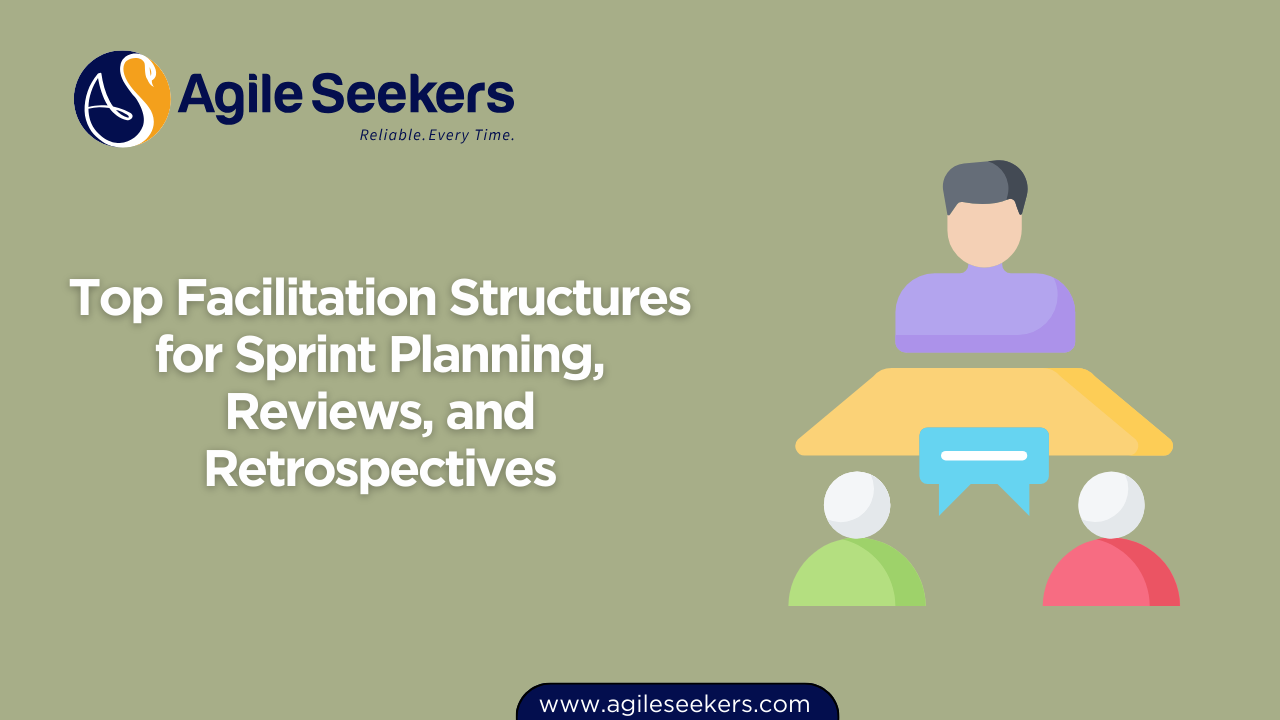Top Facilitation Structures for Sprint Planning, Reviews, and Retrospectives

Effective Scrum events don’t happen by chance—they’re the result of strong facilitation, thoughtful structure, and a clear understanding of purpose. Whether you're planning a sprint, reviewing outcomes, or reflecting as a team, how you facilitate these sessions has a direct impact on alignment, collaboration, and continuous improvement.
This post explores proven facilitation structures that Scrum Masters can use during Sprint Planning, Sprint Reviews, and Sprint Retrospectives. Each structure focuses on maximizing participation, driving clarity, and improving outcomes for Agile teams.
Why Structured Facilitation Matters in Scrum Events
Facilitation isn’t just about running meetings. It’s about creating space where team members collaborate openly, decisions are made with clarity, and the Scrum values of focus, openness, and respect are upheld.
Scrum Masters who complete certified scrum master training develop core facilitation skills that help teams move from routine meetings to purposeful Scrum events.
Sprint Planning: Structures That Drive Clarity and Commitment
Sprint Planning sets the tone for the entire iteration. The structure of this meeting determines how well the team understands the work and commits to delivering it.
1. Goal-Driven Planning
Structure:
-
Start with the Product Owner sharing the Sprint Goal.
-
Discuss how backlog items align with that goal.
-
Have the team pull items they believe they can deliver.
Benefits:
-
Keeps the team focused.
-
Promotes outcome-based thinking.
Tip: Use tools like Miro or MURAL to visually group items under the goal for distributed teams.
2. Capacity-Based Planning
Structure:
-
Identify each team member’s capacity for the sprint.
-
Use that as a baseline to decide how much work can be taken on.
-
Avoid overcommitting by considering known holidays, leaves, or carryover work.
Benefits:
-
Reduces spillover.
-
Encourages realistic commitments.
3. Split the Meeting into Two Parts
Structure:
-
Part 1 (What?) – Discuss what items will be selected (Product Owner-led).
-
Part 2 (How?) – Discuss how the work will be done (Team-led).
Benefits:
-
Keeps discussions focused.
-
Helps developers think in terms of implementation early.
Learn how facilitation is embedded in Scrum roles through our CSM certification training.
Sprint Review: Structures That Encourage Engagement and Feedback
The Sprint Review isn’t a status update—it’s an opportunity to collaborate with stakeholders and inspect the increment.
1. Demo + Dialogue Format
Structure:
-
Team demonstrates completed work.
-
Stakeholders ask questions after each feature or story.
-
Open Q&A or roadmap update at the end.
Benefits:
-
Encourages conversation.
-
Keeps feedback flowing in real-time.
2. Story Walkthrough by Developer
Structure:
-
Developers present stories they worked on, explaining value and challenges.
-
Product Owner highlights how it aligns with roadmap or goals.
-
Stakeholders provide feedback after each segment.
Benefits:
-
Builds ownership.
-
Helps stakeholders appreciate complexity.
3. Interactive Stakeholder Boards
Structure:
-
Use a virtual board (like Trello or Jamboard) where stakeholders can drop comments or questions while viewing the demo.
-
Review each item during the Q&A.
Benefits:
-
Captures silent voices.
-
Structures the feedback process.
For Scrum Masters, facilitating reviews with clarity and stakeholder engagement is a skill developed through hands-on experience and CSM training.
Sprint Retrospective: Structures That Uncover Insights and Actions
A well-structured retrospective can be the difference between surface-level observations and meaningful team improvements.
1. Start-Stop-Continue
Structure:
-
Each team member contributes to three columns:
-
What to start doing
-
What to stop doing
-
What to continue
-
-
Discuss and cluster items into themes.
-
Prioritize one or two items for action.
Benefits:
-
Easy to run.
-
Generates actionable insights.
2. Sailboat Retrospective
Structure:
-
Draw a sailboat on a whiteboard or digital tool.
-
Wind = what pushed us forward
-
Anchors = what held us back
-
Rocks = risks
-
Island = the sprint goal
-
-
Teams reflect visually and map their observations.
Benefits:
-
Encourages storytelling.
-
Makes abstract challenges concrete.
3. 4Ls Retrospective (Liked, Learned, Lacked, Longed for)
Structure:
-
Team members anonymously share their thoughts under four categories.
-
Discuss one category at a time.
-
Conclude with action items.
Benefits:
-
Surfaces emotional tone of the sprint.
-
Highlights hidden gaps.
Pro tip: Use RetroTool, FunRetro, or EasyRetro for anonymous contributions in hybrid teams.
Facilitating retrospectives well is part of the Scrum Master’s core responsibility. It’s emphasized in professional CSM certification programs that teach how to build psychological safety and foster team growth.
Comparison Table of Facilitation Structures
| Scrum Event | Structure Name | Key Focus | Primary Benefit |
|---|---|---|---|
| Sprint Planning | Goal-Driven Planning | Sprint goal alignment | Focus on outcomes |
| Sprint Planning | Split Meeting | What vs. How | Improved clarity |
| Sprint Review | Demo + Dialogue | Stakeholder feedback | Engagement |
| Retrospective | 4Ls | Team reflection | Emotional awareness |
Facilitation Tools to Support Your Scrum Events
Here are tools that support effective facilitation:
-
Miro – Ideal for visual collaboration during planning and retrospectives.
-
Jira – Useful for backlog transparency and sprint forecasting.
-
EasyRetro – Helps with online retrospectives.
-
Mentimeter – Interactive polling for reviews or retrospectives.
-
Timebox tools (like TimerTab) – Keeps meetings on track.
External resources like Scrum.org’s facilitation guide also provide practical techniques for running effective Scrum events.
Conclusion
Facilitating Scrum events with the right structure transforms them into powerful opportunities for alignment, inspection, and improvement. Scrum Masters who consistently apply proven facilitation techniques help teams stay focused, engaged, and continuously learning.
If you're looking to deepen your facilitation expertise and grow into an impactful Scrum Master, consider enrolling in CSM training to build your practical and theoretical foundation.
Also read - Agile Coaching Techniques Every Scrum Master Should Learn
Also see - Scrum in Regulated Industries




















